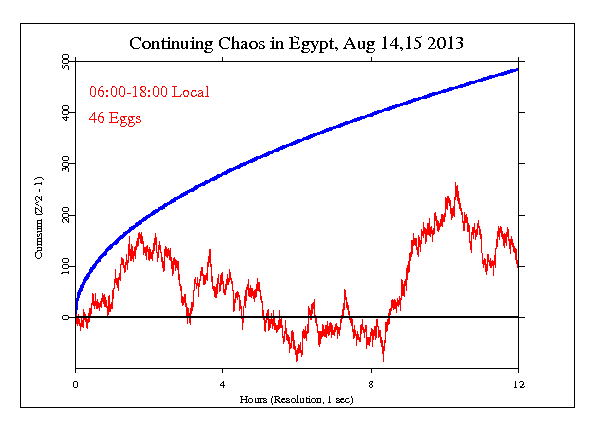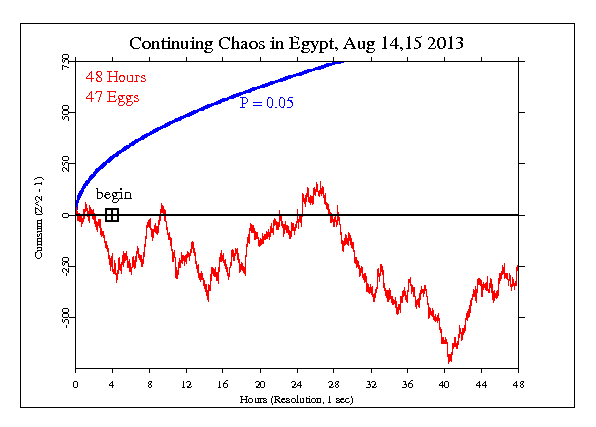|
From The Nation: Chaos and Bloodshed in the Streets of Cairo.
At the time of this report, 9 am, more than 250 were reported
killed, including 3 journalists. Later in
the day the count of fatalities was over 600, with thousands of injured.
Wed Aug 14, 9 am local.
Hours after the raids began, Egypt’s military-backed interim president
declared a month-long state of emergency, allowing security forces to
detain civilians indefinitely and without charge, and imposed a
nighttime curfew in Cairo and ten other governorates.
The health ministry said 235 people were killed across the country,
although the death toll is expected to rise. The Muslim Brotherhood put
the toll at over 2,000, calling the crackdown a “massacre.”
Among those killed were two journalists, Mick Deane, 61, a cameraman for
Sky News, and Habiba Ahmed Abd Elaziz, 26, a reporter for the
Dubai-based newspaper Xpress. Muslim Brotherhood leader Mohamed
El-Beltagi said his 17-year-old daughter, Asmaa, was also shot dead.
In a press conference, the Interior Minister said forty-three policemen
were also killed.
The raids came despite weeks of international diplomacy aimed at
resolving the political crisis and staving off further violence, and
they have all but ended the possibility of a political process that
could include the Muslim Brotherhood in the near future. Morsi’s
supporters had been calling for his reinstatement as president and the
reversal of what they call a “coup against legitimacy.”
Security officials said Beltagi and other senior Brotherhood figures,
including Essam al-Erian, have been arrested. Morsi himself has been
held in an undisclosed location since he was deposed by the military on
July 3 following mass protests against his rule.
Mohamed ElBaradei, a Nobel Peace Prize laureate and vice president of
international affairs in the interim cabinet who had vocally urged
against a forcible dispersal of the sit-ins, submitted his resignation
over the crackdown. “I cannot bear the responsibility for a single drop
of blood,” he said in a statement. “What happened today is only in the
interest of advocates of violence, terrorism and extremist groups.”
ElBaradei was the most prominent figure to take part in the transitional
government following Morsi’s ouster, and his resignation underscored the
fact that the military is the real power now in Egypt.
Plans to forcibly disperse the two sit-ins had been previously
announced, with the police stating that they would first provide a
warning, then use gradually escalating tactics. The plans came in the
wake of the interim cabinet authorizing the Interior Ministry to clear
the encampments and amid shrill rhetoric in much of the media that often
referred to the protesters as violent terrorists.
The raids began shortly after 6 AM, according to witnesses, with
security forces deploying bulldozers, helicopters, snipers, shotguns and
tear gas. The smaller of the two sit-ins, at Renaissance Square in Giza,
was cleared within hours. But the raid of the much larger encampment, at
the Rabaa al-Adeweya mosque in Nasr City, a neighborhood in eastern
Cairo, lasted far longer.
In Nasr City, the crackle of intermittent machine-gun fire punctuated
the rhythmic clang of metal poles the protesters were beating to warn of
the ongoing attack. Tear gas mixed with black smoke rising from burning
tires and branches pulled from trees on the sidewalk.
It was a scene of chaos and bloodshed inside the Rabaa medical facility,
a four story building near the central mosque. Wounded protesters were
carried in every few minutes, many of them shot in the chest, neck or
abdomen. The floor was covered in grime and, in places, slippery with
blood. The heat was stifling, since the windows had been closed to
prevent tear gas from entering.
Overwhelmed doctors and volunteer medics were forced to tend to the
wounded in the crowded hallways. “We only have two operating rooms, and
we can’t transfer patients because the police are blocking the exits
outside,” said Mohamed Abdel Aziz, a volunteer medic.
The GCP event was set for 12 hours beginning with the bulldozing of the
protest camps, following the suggestion of Hans Wendt. The result is
Chisquare 43303.954 on 43200 df, for p = 0.361 and Z = 0.356.
(Formal analysis was corrected after one bad egg removed.)

The chaos continues, and the casualties mount. One of the most important
of these is the possibility of collaborating, cooperating, connecting.
At this moment, these positive ways are suppressed in favor of conflict,
violence, death. Who is making money? Why do we still, with modern
communication, allow ourselves to do this? We are all there, shooting
and being shot because we will not leap forward into the future of
humanity. Are we afraid? Or is it really in the interest of the few to
have the many split into foes and enemies, the other. We are not other.
We are one -- and anyone who intends the splitting is evil.
Here is a graph of the continuing period of chaos in Cairo. It begins
before the army and police brought the weapons of war to bear on the
camps of demonstators. There is a 4 hour period leading to the
bulldozing and the beginning of killing. Live ammunition, not rubber
bullets. Who profits? Who let the army, designed for violence, take over?

It is important to keep in mind that we have only a tiny
statistical effect, so that it is always hard to distinguish
signal from noise. This means that every "success" might be
largely driven by chance, and every "null" might include a real
signal overwhelmed by noise. In the long run, a real effect can
be identified only by patiently accumulating replications of
similar analyses.
|